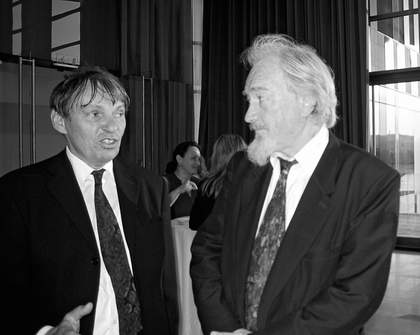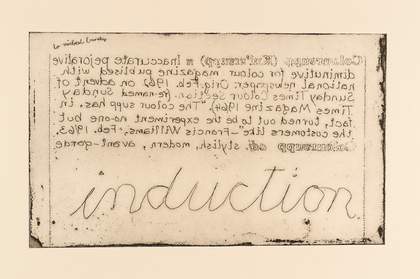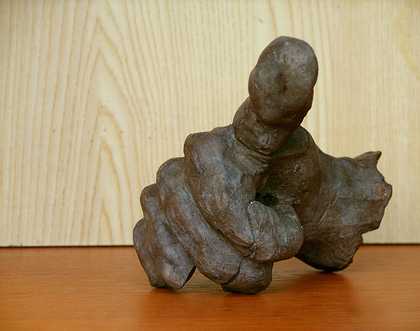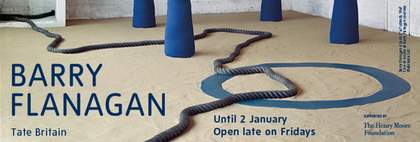Paul Levy
We had known Barry for a few years when Penelope Marcus and I married in 1977. He designed the invitation, the wine bottle labels and the guest book, carved a motif in a wooden bench as a wedding present and hared around the back roads of Oxfordshire in the early hours of 26 June, buying bacon and eggs from the float of every milkman he could find (you could then). He had rightly judged our catering arrangements for the 500 guests to be inadequate, and he cooked breakfast for the remaining dozens of guests who had danced through the night. Within a year or two, we had commissioned a piece from Barry, to be sited on one of the lawns of our old farmhouse, and carved of Hornton stone, the north Oxford limestone that Henry Moore loved. The deal was that I paid him (I think) £10 a week by standing order. There was no terminal date, as he was even less well-off than we, and the steady, if small, cash flow helped with basic household needs. In fact, he started being successful fairly quickly, and I had paid him only a couple of hundred pounds when he told me to cancel the standing order. Barry must have had a van to transport the heavy piece, which was frankly phallus-shaped, narrowing from its almost square base to its metre-high tip, carved from gingerbread-coloured stone with three mortise and tenon joints. The top was painted green, and it came with a pot of paint and instructions to coat the whole sculpture with melted beeswax now and again. Called Oil Rising (a reference to the newly discovered riches of the North Sea), it was a thing of wonder, placed by Barry in front of a long rectangular bed with a low lavender hedge in front, and a very high curving wall at the back, against which were trained a fig and three ancient espaliered pear trees. There are photographs showing our most recent litter of kittens scampering over it.
But there were two catastrophes. First, Penny, melting the beeswax, set fire to the kitchen. Secondly, and more seriously, Barry’s lack of experience with Hornton stone at the time meant that he had not yet learned to dress it properly. It failed to survive its first winter, and the last photograph we have of him at our house shows him in December 2008, contemplating the ruins of Oil Rising.
Andrew Dipper
In the 1960s I studied fine art, and learned important lessons from my various tutors, among them William Pye, William Turnbull, John Warren Davis and Brian Wall. But it was the arrival of Barry Flanagan in the studio one day in 1967 that proved to be the most inspirational. The first thing he wanted to do was to look at my drawing. A lesson on Matisse ensued, and it took Barry exactly ten minutes to explain the minutely engineered workings of the economy of line in a Matisse drawing, and how and why each line needed to endure on the surface of the paper. His verbal phrasing and the finesse of his understanding of the artistic process were so rich that in a very short time my own work became infused with a new and revolutionary spirit of enquiry. I went on to work for Barry as a studio assistant, and he consistently gave me insights into the link between conceptual art and sculptural expression. Words became form, and form became words, so much so that when on occasion I was invited to have lunch with him at the Polish Club, in South Kensington, the lines were blurred between food for thought and thought for food. I will always consider him as one of my great teachers and foundation stones of my continuing obsession with the fine arts.
In 1969 he and I did a portable sculpture project on the corner of Agar Grove and Murray Street in Camden. He had rented an open-bed truck that had a cement mixer, a sewing machine and a wheelbarrow on the back. We pulled up in the truck and he sewed a number of large dark blue canvas bags on the spot. We mixed the cement, filled the bags with sand and placed them at various points on the street – as bollards. I think we anchored them to the spot with rebar, hammered into holes in the paving. Barry wanted to do the piece in protest at the council’s plans to erect a large number of permanent bollards on the same site.
Braco Dimitrijevic: Triptych for Barry
It is not easy to describe Barry. A few attributes and definitions come to my mind, but none can capture his exceptional personality: naturally born eccentric, enigmatic, curious, open to experiment, elegant, loyal to his friends, honest, pluralist by taste, charming, generous, social, individualist, rebellious, courageous, fast thinker, good sense of humour, full of surprises both in his private life and in his art, true gentleman and a genius sculptor.
Picture One
I met Barry in 1970 when I was 22, at a time when the conceptual art world was a small group. I had been given his telephone number by a fellow artist friend, Jan Dibbets. Our first meeting: I knock at the door of 8 Cliff road, Camden Town, north London with a certain excitement of the prospect of meeting an older colleague whose work I admire. Barry opens the door and a few minutes later we are sitting in his living room. While he is making tea, I observe the space around me. It is obvious that the furniture has been designed by him: some funny soft objects similar to his sculptures were scattered on the floor in place of armchairs. One of his casbs was still in his house (it was later acquired by Tate). We met his wife Sue and their two little daughters Samantha (Flan) and Tara. We liked them a lot and were impressed by the eccentric display of artworks and nonchalant elegance of their household. Just before we left London, Barry invited us for dinner. He was wearing a nice tweed jacket and, for some inexplicable reason, two shirts – one on top of the other. I had a feeling that a new friendship was born.
Picture Two
Among our numerous meetings in many cities was a memorable visit to Barry’s countryside home near Oxford. It was in the autumn of 1975. The Flanagans had left London in search of a quieter life. My train arrived two hours late, but he was still waiting for me at the misty station. On the drive to his house he told me how, after his show at the Museum of Modern Art Oxford, he was disillusioned with the art world and had started working as a dentist’s assistant modelling plaster tooth casts. During that drive I wondered if there was anything closer to the paradox of the readymade than Barry Flanagan dental casts.

Braco Dimitrijevic and Barry Flanagan at the opening of Dimitrijevic's retrospective, Museum Ludwig, Budapest (2008)
Courtesy Braco Dimitrijevic
Picture Three
In the spring of 2008 I invited Barry to my 60th birthday party, which coincided with the opening of my retrospective at the Museum Ludwig in Budapest. He showed up two days before. It was the best birthday present I could have hoped for. I had a big birthday party on a boat cruising on the Danube with gypsy music. Afterwards, we had a quiet drink together. I did not know then that it would be my last drink with Barry.
Andy Holden
After striking up a friendship with Mr Flanagan, he came along to see a small exhibition of mine, which included the first bronze piece I had made. You Go On Without Me 2008, a hand with thumb outstretched, was a crude attempt to capture, with a figurative act, something fleeting, a simple gesture made monument. I’m not sure if he liked it very much. However, he looked at it for a long time, circled it, asked a bit about the foundry.
The next day we met again to record an interview. I asked him a lot of questions – about public sculpture, figuration, language, pragmatism, trade, poetry, plinths and gravity – almost all of which he answered tangentially or seemed to avoid altogether, instead recounting autobiographical stories that would, as if by chance, illuminate or touch the edge of the subject. However, the work perhaps encourages digression, and it brought to mind a quotation by Albert Camus: “A man’s work is nothing but the slow trek to rediscover through the detours of art, those two or three great and simple images in whose presence his heart first opened.” There was one such image I particularly wanted to ask him about – the relationship between the very light, or nimble, and the very heavy or grounded that seems to occur in so many of his sculptures, epitomised in the hare leaping over the pyramid. To this Mr Flanagan replied:
“I never witnessed Nureyev dancing, but the word was there were times when he did seem to almost, through his gesture, be suspended in mid-air. In sculpture, it seems to me, yes, the inert deserves a little lift.”



